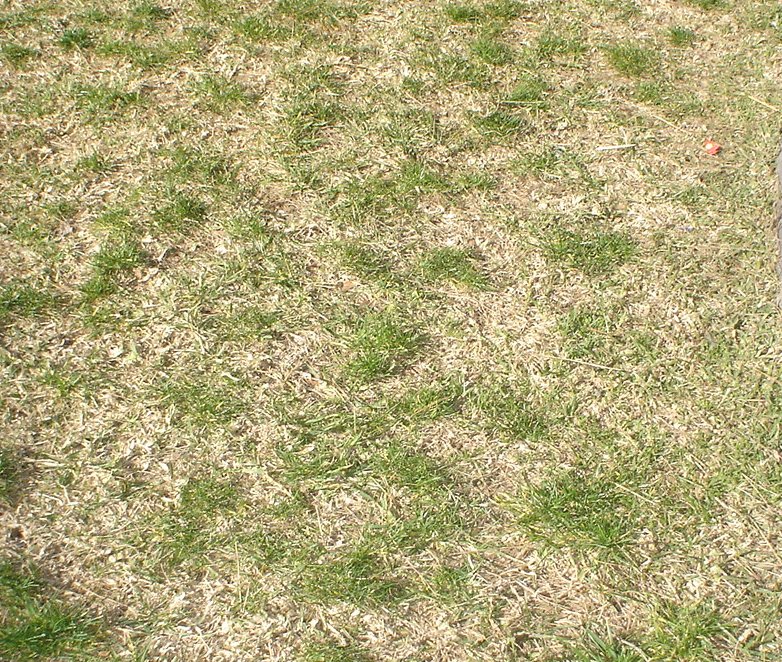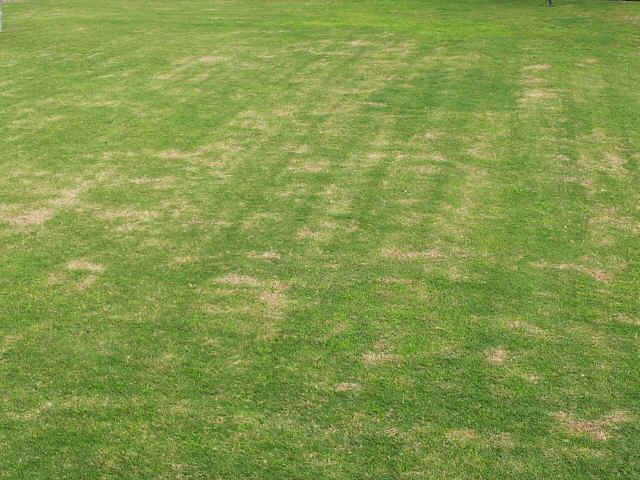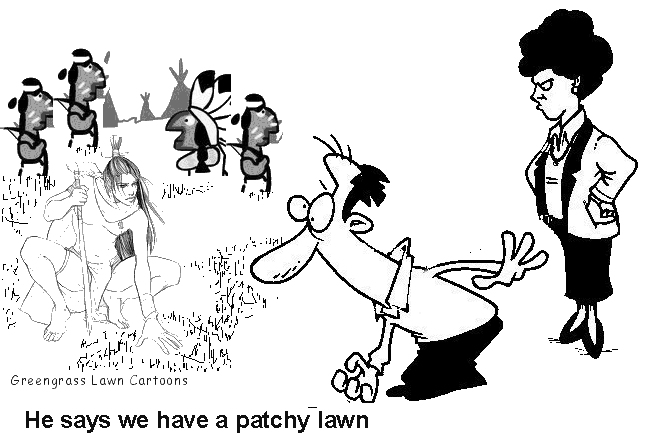Patchy Lawn
 |
 |

|
| Picture of a warm season lawn with some cold season patches (picture taken in January) | Picture of a badly neglected lawn with over 5 types of different types of grass, all growing at different rates, heights, textures and colours |
A patchy lawn can have too many different types of grass and either looks like a patchwork quilt of differing colours and textures of green, a lawn that has areas of unhealthy brown or yellow grass, a lawn that grows at different rates or a lawn that has areas of dead grass or weeds. |
You could use miracle grow patch magic, but unfortunately there is a little more to repairing a patchy lawn. After all, what type of grass do you actually have in your lawn? Is it the result of several grass seed mixtures?
You don't want to end up with a completely different colour and texture of grass!! It is possible, by diligent use of selective weed killers, changing the height of your mowing, altering your watering regime and a little overseeding to fine tune your lawn to look spectacular once again.
If you need advice contact
us and we will write you a step by step schedule of what to do.
 The most common
cause of a patchy lawn ...
The most common
cause of a patchy lawn ...![]()
Years of neglect will certainly produce a
patchy lawn.
Spending almost nothing or
doing nothing does not produce a nice looking lawn.
Lack of watering a newly seeded lawn will reduce the germination rate from 95% to less than 50%. The immediate reaction will be blamed on uneven sowing, but the results will be patchy areas of grass versus soil.
Hide this content.
Why not ask for a Lawn Survey from us?
The next most common reason for a patchy lawn still remains the wrong type of grass (i.e. cold season grass) that has been sown as a seed mixture or bought as turf, and after insufficient watering for the Mediterranean climate and when the temperature increases, the weaker, finer grasses have died leaving the coarser grasses in patches.
Seeding a new lawn is tricky. There are so many things that can go wrong. The net result can be a patchy lawn that needs to be reseeded in the bald patches. See Patchy Lawns Explained.
This problem is the result of buying different packets of lawn
seed and repeatedly overseeding, combined with invasive grasses like
crabgrass or ryegrass dominating your required garden lawn effect.
It may be that none of the types of grasses are actually suitable for what you want
as a lawn, or maybe some of your lawn is ok. some
suggestions...![]()
2) Remove unwanted grass by
hand.
3) If you have a
fine grass lawn then getting the right selective weed killer applied
at the correct strength will kill the unwanted grass. This is risky
and sample areas should be tested first.
4) There ARE certain weed
killers that WILL kill certain unwanted grasses. There are also
pre-emergent weed killers that will kill grasses like Crabgrass as
it germinates. This solution is suitable for annual
grasses, certain warm season grasses and works best at certain times of the
year. Contact
us for details of what weed killers are suitable for your type
of grass.
5) Dig
up the areas of unwanted lawn and replant or reseed with the
required grass. I prefer this method, however deep rooted weed
grasses will pose a problem, because digging up the turf will still
leave the roots and rhizomes in the soil. My preferred method is to spot apply
total weed killer to the unwanted areas of grass and wait the required
time for the grass to die. Then dig up the patch of turf and replace with turf of the correct type.
This method will inevitably mean that you will have rotating brown
patches in your lawn during the replacement period, but is certainly
effective over a 6 month period. Tip: I have a special area of lawn that is grown specifically for the purpose of replacement turf.
Dig it up and use it for patching up your lawn.
Tip: I have a special area of lawn that is grown specifically for the purpose of replacement turf.
Dig it up and use it for patching up your lawn.
6) Total weed kill. If there are too many types of grass in your lawn,
and the problem has got out of hand, then all the living growth
should be eradicated ASAP. Simply put, a mish mash of different grasses will never produce the
desired lawn effect. Bite the bullet and get stuck in. Once all growth has been eradicated with a total herbicide, the new
choice of grass can be laid. This is a radical and not always
possible solution.
7) Mow the lawn at the height to
encourage the grasses you want. This will choke out the unwanted
species.
* Note: It is a complete waste of
time and money to lay turf over unprepared soil, all weeds and
unwanted types of grass will grow through the turf in months. A lawn
repair should still be performed.
Hide this content.
Getting rid of weeds can easily be achieved by selective broad leaved weed killer, but once weeds get a hold on a lawn, then killing all the weeds at once will result in large areas of yellow or brown. Once weeds have taken hold, a planned weed control regime should be followed. Why not ask for a Lawn Survey from us?
 More
Tips...
More
Tips...![]()
For treatment
ideas contact
us or see our Brown Patch, Magic Lawn Repair
Kit
Hide this content.


